|
Have a safe day!
Tuesday, Dec. 6
3 p.m.
LHC Physics Center Topic of the Week Seminar - WH11NE Sunrise
Speaker: Mariangela Lisanti, Princeton University
Title: Study of LHC Searches for a Lepton and Many Jets
3:30 p.m.
Particle Astrophysics Seminar - WH7 Crossover Racetrack
Speaker: Keith Bechtol, Stanford University
Title: The Extragalactic Gamma-Ray Background: A Census of High Energy Phenomena in the Universe
3:30 p.m.
DIRECTOR'S COFFEE BREAK - 2nd Flr X-Over
THERE WILL BE NO ACCELERATOR PHYSICS AND TECHNOLOGY SEMINAR TODAY
Wednesday, Dec. 7
10 a.m.
Particle Astrophysics Seminar - Dark Side WH6W
Speaker: Luca Grandi, Princeton University
Title: The Dark Side of Dark Matter
12:30 p.m.
Physics for Everyone - Ramsey Auditorium
Speaker: Stuart Henderson, Fermilab
Title: Project X: A Powerful Accelerator for Particle Physics
3:30 p.m.
DIRECTOR'S COFFEE BREAK - 2nd Flr X-Over
4 p.m.
Fermilab Colloquium -
One West
Speaker: Itai Cohen, Cornell University
Title: Flight of the Fruit Fly
Click here for NALCAL,
a weekly calendar with links to additional information.
Upcoming conferences
|
|
Tuesday, Nov. 29
- Breakfast: Bagel sandwich
- Golden broccoli cheese soup
- Fish & chips
- Coconut crusted tilapia
- Burgundy beef tips
- La grande sandwich
- Assorted sliced pizza
- Chicken fajitas
Wilson Hall Cafe Menu
|
|
Wednesday, Dec. 7
Lunch
- Bourbon & brown sugar flank steak
- Chipotle-maple sweet potatoes
- Green beans
- Chocolate pecan pie
Friday, Dec. 9
Dinner
- Red pepper soup
- Lobster tail
- Spinach w/ scallions & lemon
- Lemon orzo
- Parfait w/ cookies
Chez Leon Menu
Call x3524 to make your reservation.
|
|
MiniBooNE achieves record
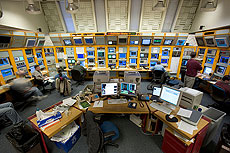 |
|
The Main Control Room in the Accelerator Complex at Fermilab. Photo: Reidar Hahn
|
In the early morning hours of Sept. 28, the MiniBooNE experiment surpassed a special milestone. It collected data from 1021 protons on target in anti-neutrino mode. This is significant because for every 1016 protons on target, there are approximately two antineutrino events produced in the detector. Thus, the more protons on target the more antineutrinos produced for analysis. This milestone was delivered by Accelerator Division, and the huge number of protons resulting from stable running over the course of many years. It is equivalent to almost two milligrams of protons accelerated to the speed of light. This is an amazing achievement and reflects the hard work and dedication of AD.
This is a lot of data, but we are not done yet. Given the low rate of antineutrino production, we need to collect 1.5 x 1021 protons on target to produce enough data to reach our analysis goal. Adding up all the neutrino, antineutrino and special runs over the last decade, we have a total of 1.8 x 1021 protons on target, which puts us at the extreme edge of the intensity frontier. The MiniBooNE personnel look forward to further running and, with the outstanding help of AD, to continue pushing the limits of the Intensity Frontier.
|
Service awards - Nov. 4
On Nov. 4, Fermilab employees were recognized for their years of service to the laboratory.
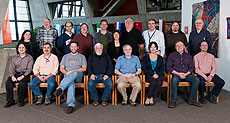 |
|
10 Years of Service: First row, from left: Huan Lin, CD; Vitali Tupikov, AD; Chip Edstrom, AD; Jerry Nelson, AD; William Tanenbaum, CD; Angela Wan, FS; Alex Kulyavtsev, CD; and Gordon Bagby, BSS. Second row, from left: Kathryn Duerr, BSS; Nikolay Kuropatkin, CD; Stephen Mrenna, CD; Robert Hatcher, CD; Marc Kaducak, TD; Young-Kee Kim, DIR; Wayne Ostrom, TD; Timergali Khabiboulline, TD; Kevin Hill, CD; Bruce Chrisman, DIR.
|
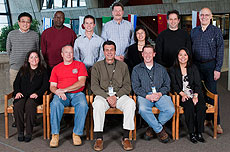 |
|
20 Years of Service: First row, from left: Patricia Cameron, CD; Brian Petersohn, FESS; Virgil Bocean, PPD; Brian Drendel, AD; and Colleen Yoshikawa, PPD. Second row, from left: Weimin Wu, PPD; Cosmore Sylvester, TD; Dale Knapp, PPD; Mark Kujawa, FESS; Young-Kee Kim, DIR; Scott Dodelson, PPD; and Bruce Chrisman, DIR.
|
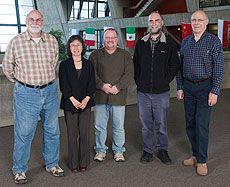 |
|
25 Years of Service: From left: Rick Van Conant, CD; Young-Kee Kim, DIR; Lonnie LaSourd, BSS; Peter Kasper, PPD; and Bruce Chrisman, DIR.
|
|
Focus: Another step back for wave-particle duality
From Physics.org, Dec. 2, 2011
A new thought experiment makes it clearer than ever that photons aren’t simply particles or waves.
Quantum physics tells us that a photon isn’t strictly a particle or strictly a wave. And yet most of us will revert back—whenever we can—to familiar concepts of billiard balls or vibrating strings when picturing photons in our heads. A new thought experiment, proposed in Physical Review Letters, hopes to break us of these old habits. The authors imagine a type of quantum switch that controls whether a simple optical measurement tests for particlelike or wavelike behavior in a single photon. This slight reworking of a famous experiment demonstrates with logical precision the futility of trying to label the photon as a particle or a wave.
The wave-particle duality is often illustrated by splitting a light beam so that it travels along two separate paths that later merge to form an interference pattern from the combined beams. For a dim beam delivering photons one-at-a-time, this interference suggests that each photon is a wave that travels down both paths simultaneously. But if the paths are observed individually, then the photon will behave like a particle, traveling down only one path or the other and generating no interference.
Read more
|
|
Intensity Frontier workshop II
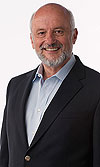 |
|
Fermilab Director Pier Oddone |
Last week’s workshop in Washington DC was remarkable in several ways: a very high attendance, a very high level of energy and an excellent exposition of the broad and exciting scientific program at the Intensity Frontier. With the leadership at the Energy Frontier moving to Europe and the LHC for the next two decades, the workshop demonstrated that programs and projects at the Intensity Frontier also give us the opportunity to answer many of the fundamental scientific questions of our era.
The study of neutrinos and rare processes allows us to investigate energies much higher than those accessible at the LHC, albeit in an indirect way. It is very much an open question whether we will be able to develop technologies for new particle colliders that will directly produce energies much higher than at the LHC, or that any such technology will be affordable. In the meantime the Intensity Frontier will be a very active area of exploration no matter what LHC scientists find. At one limit, where the LHC pours out new physics phenomena, the Intensity Frontier will be essential to help us interpret what we see at the LHC. At the other limit, where the LHC gives us a paucity of new results, processes we study at the Intensity Frontier will give us the only handle on the physics of the next energy scale.
The opportunities for physics must come first, but they do not make a healthy program by themselves. To tackle these opportunities is a great challenge that will advance our accelerator, detector and computational technologies, push our ability to manage large projects integrating national and international partners, and challenge us with the analysis and theoretical interpretation of the results. Fermilab has a central role in working with the scientific community to define the opportunities—the focus of last week’s workshop--and to meet the great challenge of implementing a world-class program.
The raison d’etre for national laboratories is an enabling function: to tackle scientific problems of scale that are important for the nation and demand multidisciplinary teams, unique facilities, infrastructure and a critical mass of talent. To the extent that they fulfill this mission, laboratories have a healthy program and serve the community. Thanks to the strengths built at Fermilab over the last many years we are in a unique position to enable the national and international community to take the next steps at the Intensity Frontier.
|
Astronomers find biggest black holes yet
From The New York Times, Dec. 5, 2011
Don’t get too close.
Astronomers are reporting that they have taken the measure of the biggest, baddest black holes yet found in the universe, abyssal yawns 10 times the size of our solar system into which billions of Suns have vanished like a guilty thought.
Such holes, they say, might be the gravitational cornerstones of galaxies and clues to the fates of the violent quasars, almost supernaturally powerful explosions in the hearts of young galaxies, that dominated the early years of the universe.
Read more
|
|